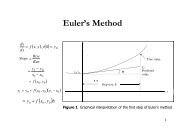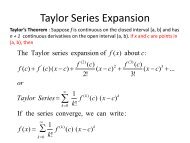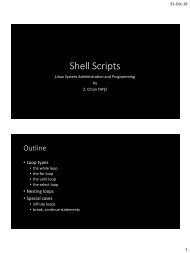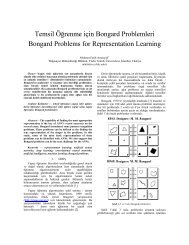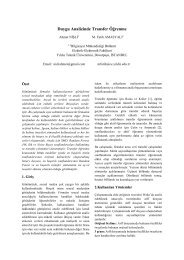ALGORITHMS PART 1
02+-+Algorithms_p1
02+-+Algorithms_p1
Create successful ePaper yourself
Turn your PDF publications into a flip-book with our unique Google optimized e-Paper software.
08-Oct-16<br />
<strong>ALGORITHMS</strong> <strong>PART</strong> 1<br />
INTRODUCTION TO COMPUTER ENGINEERING<br />
BLMXXXX<br />
ASIST. PROF. DR. Z. CIHAN TAYŞİ<br />
OUTLINE<br />
• Fundamental concepts<br />
• A little history, definition, design & analyzing<br />
• Complexity<br />
• Flow charts<br />
• Elements, connections<br />
• Pseudo codes<br />
1
08-Oct-16<br />
FUNDAMENTAL CONCEPTS<br />
DEFINITION, DESIGN & ANALYZING<br />
A LITTLE HISTORY<br />
• Muhammad ibn Musa Al-Khwarizmi<br />
• Few details of al-Khwārizmī's life are known with certainty. He was born in a Persian[3] family and Ibn al-Nadim<br />
gives his birthplace as Khwarezm[9] in Greater Khorasan (modern Xorazm Region, Uzbekistan).<br />
• http://www-groups.dcs.st-andrews.ac.uk/~history/Mathematicians/Al-Khwarizmi.html<br />
• Book on arithmetic:<br />
• Hindu numeration, decimal numbers, use of zero, method for finding square root<br />
• Latin translation (c.1120 CE): “Algoritmi de numero Indorum”<br />
• Book on algebra<br />
• Hisab al-jabr w’al-muqabala<br />
2
08-Oct-16<br />
DEFINITION<br />
• the central concept underlying all computation is that of the algorithm<br />
• an algorithm is a step-by-step sequence of instructions for carrying out some task<br />
• programming can be viewed as the process of designing and implementing algorithms that a computer<br />
can carry out.<br />
• a programmer’s job is to:<br />
• create an algorithm for accomplishing a given objective, then<br />
• translate the individual steps of the algorithm into a programming language that the computer can understand<br />
DEFINITION CONT’D<br />
• Algorithms are well-defined sequence of<br />
unambiguous instructions<br />
• Example: Manual Addition<br />
• must terminate (to produce a result)<br />
• Algorithm description relies on a well-defined<br />
“instruction language”<br />
Describe the method!<br />
123456<br />
+ 789001<br />
912457<br />
3
08-Oct-16<br />
DEFINITION<br />
• the use of algorithms is not limited to the domain of computing<br />
• e.g., recipes for baking cookies<br />
• e.g., directions to your house<br />
• there are many unfamiliar tasks in life that we could not complete without the aid<br />
of instructions<br />
• in order for an algorithm to be effective, it must be stated in a manner that its intended<br />
executor can understand<br />
• a recipe written for a master chef will look different than a recipe written for a college student<br />
• as you have already experienced, computers are more demanding with regard to<br />
algorithm specifics than any human could be<br />
DESIGNING & ANALYZING <strong>ALGORITHMS</strong><br />
• 4 steps to solving problems (George Polya)<br />
1. understand the problem<br />
2. devise a plan<br />
3. carry out your plan<br />
4. examine the solution<br />
• EXAMPLE: finding the oldest person in a room<br />
full of people<br />
1. understanding the problem<br />
• initial condition – room full of people<br />
• goal – identify the oldest person<br />
• assumptions<br />
<br />
<br />
<br />
a person will give their real birthday<br />
if two people are born on the same day, they are<br />
the same age<br />
if there is more than one oldest person, finding<br />
any one of them is okay<br />
2. we will consider 2 different designs for solving<br />
this problem<br />
4
08-Oct-16<br />
ALGORITHM 1<br />
• Finding the oldest person (algorithm 1)<br />
1. line up all the people along one wall<br />
2. ask the first person to state their name and<br />
birthday, then write this information down on a<br />
piece of paper<br />
3. for each successive person in line:<br />
i. ask the person for their name and birthday<br />
ii.<br />
if the stated birthday is earlier than the birthday<br />
on the paper, cross out old information and write<br />
down the name and birthday of this person<br />
• when you reach the end of the line, the name<br />
and birthday of the oldest person will be written<br />
on the paper<br />
ALGORITHM 2<br />
• Finding the oldest person (algorithm 2)<br />
1. line up all the people along one wall<br />
2. as long as there is more than one person in the<br />
line, repeatedly<br />
i. have the people pair up (1 st with 2 nd , 3 rd with 4 th ,<br />
etc) – if there are an odd number of people, the<br />
last person will be without a partner<br />
ii.<br />
iii.<br />
ask each pair of people to compare their<br />
birthdays<br />
request that the younger of the two leave the<br />
line<br />
• when there is only one person left in line, that<br />
person is the oldest<br />
5
08-Oct-16<br />
ALGORITHM ANALYSIS<br />
• determining which algorithm is "better" is not<br />
always clear cut<br />
• it depends upon what features are most important<br />
to you<br />
• if you want to be sure it works, choose the /clearer algorithm<br />
• if you care about the time or effort required, need to analyze performance<br />
• algorithm 1 involves asking each person’s birthday<br />
and then comparing it to the birthday written on<br />
the page<br />
• the amount of time to find the oldest person is<br />
proportional to the number of people<br />
• if you double the amount of people, the time<br />
needed to find the oldest person will also double<br />
• algorithm 2 allows you to perform multiple<br />
comparisons simultaneously<br />
• the time needed to find the oldest person is<br />
proportional to the number of rounds it takes to<br />
shrink the line down to one person<br />
• which turns out to be the logarithm (base 2) of the<br />
number of people<br />
• if you double the amount of people, the time<br />
needed to find the oldest person increases by a<br />
factor of one more comparison<br />
ALGORITHM ANALYSIS<br />
• for algorithm 1:<br />
• 100 people 5*100 = 500 seconds<br />
• 200 people 5*200 = 1000 seconds<br />
• 400 people 5*400 = 2000 seconds<br />
• . . .<br />
• 1,000,000 people 5*1,000,000 = 5,000,000<br />
seconds<br />
• for algorithm 2:<br />
• 100 people 5* log 100 = 35 seconds<br />
• 200 people 5* log 200 = 40 seconds<br />
• 400 people 5* log 400 = 45 seconds<br />
• . . .<br />
• 1,000,000 people 5* log 1,000,000 = 100<br />
seconds<br />
when the problem size is large, performance differences can be dramatic<br />
for example, assume it takes 5 seconds to compare birthdays<br />
6
08-Oct-16<br />
BIG-OH NOTATION<br />
• to represent an algorithm’s performance in relation to the size of the problem, computer scientists use<br />
what is known as Big-Oh notation<br />
• executing an O(N) algorithm requires time proportional to the size of problem<br />
• given an O(N) algorithm, doubling the problem size doubles the work<br />
• executing an O(log N) algorithm requires time proportional to the logarithm of the problem size<br />
• given an O(log N) algorithm, doubling the problem size adds a constant amount of work<br />
• based on our previous analysis:<br />
• algorithm 1 is classified as O(N)<br />
• algorithm 2 is O(log N)<br />
ANOTHER ALGORITHM EXAMPLE<br />
• SEARCHING: a common problem in computer science involves storing and maintaining large amounts of data,<br />
and then searching the data for particular values<br />
• data storage and retrieval are key to many industry applications<br />
• search algorithms are necessary to storing and retrieving data efficiently<br />
• e.g., consider searching a large payroll database for a particular record<br />
• if the computer selected entries at random, there is no assurance that the particular record will be found<br />
• even if the record is found, it is likely to take a large amount of time<br />
• a systematic approach assures that a given record will be found, and that it will be found more efficiently<br />
• there are two commonly used algorithms for searching a list of items<br />
• sequential search – general purpose, but relatively slow<br />
• binary search – restricted use, but fast<br />
7
08-Oct-16<br />
SEQUENTIAL SEARCH<br />
• sequential search is an algorithm that involves examining each list item in sequential order until the desired item is found<br />
• sequential search for finding an item in a list<br />
1. start at the beginning of the list<br />
2. for each item in the list<br />
i. examine the item - if that item is the one you are seeking, then you are done<br />
ii. if it is not the item you are seeking, then go on to the next item in the list<br />
3. if you reach the end of the list and have not found the item, then it was not in the list<br />
• sequential search guarantees that you will find the item if it is in the list<br />
• but it is not very practical for very large databases<br />
• worst case: you may have to look at every entry in the list<br />
BINARY SEARCH<br />
• binary search involves continually cutting the desired search list in half until the item is found<br />
• the algorithm is only applicable if the list is ordered<br />
• e.g., a list of numbers in increasing order<br />
• e.g., a list of words in alphabetical order<br />
• binary search for finding an item in an ordered list<br />
1. initially, the potential range in which the item could occur is the entire list<br />
2. as long as items remain in the potential range and the desired item has not been found, repeatedly<br />
i. examine at the middle entry in the potential range<br />
ii. if the middle entry is the item you are looking for, then you are done<br />
iii. if the middle entry is greater than the desired item, the reduce the potential range to those entries left of the middle<br />
iv. if the middle entry is less than the desired item, the reduce the potential range to those entries right of the middle<br />
• by repeatedly cutting the potential range in half, binary search can hone in on the value very quickly<br />
8
08-Oct-16<br />
BINARY SEARCH EXAMPLE<br />
• suppose you have a sorted list of state<br />
names, and want to find Illinois<br />
1. start by examining the middle entry<br />
(Missouri)<br />
• since Missouri comes after Illinois<br />
alphabetically, can eliminate it and all<br />
entries that appear to the right<br />
2. next, examine the middle of the<br />
remaining entries (Florida)<br />
• since Florida comes before Illinois<br />
alphabetically, can eliminate it and all<br />
entries that appear to the left<br />
3. next, examine the middle of the<br />
remaining entries (Illinois)<br />
• the desired entry is found<br />
SEARCH ANALYSIS<br />
• sequential search<br />
• in the worst case, the item you are looking for is in<br />
the last spot in the list (or not in the list at all)<br />
• as a result, you will have to inspect and compare every entry in the list<br />
• the amount of work required is proportional to the<br />
list size<br />
sequential search is an O(N) algorithm<br />
• binary search<br />
• in the worst case, you will have to keep halving the<br />
list until it gets down to a single entry<br />
• each time you inspect/compare an entry, you rule out roughly half the<br />
remaining entries<br />
• the amount of work required is proportional to the<br />
logarithm of the list size<br />
binary search is an O(log N) algorithm<br />
• imagine searching a phone book of the United<br />
States (280 million people)<br />
• sequential search requires at most 280 million<br />
inspections/comparisons<br />
• binary search requires at most log(280,000,000) =<br />
29 inspections/comparisons<br />
9
08-Oct-16<br />
ANOTHER ALGORITHM EXAMPLE<br />
• Newton’s Algorithm for finding the square root<br />
of N<br />
1. start with an initial approximation of 1<br />
2. as long as the approximation isn’t close enough,<br />
repeatedly<br />
i. refine the approximation using the formula:<br />
newApproximation = (oldApproximation + N/oldApproximation)/2<br />
• example: finding the square root of 1024<br />
ANOTHER ALGORITHM EXAMPLE CONT’D<br />
• algorithm analysis:<br />
• Newton's Algorithm does converge on the square root because each successive approximation is closer than<br />
the previous one<br />
• however, since the square root might be a nonterminating fraction it becomes difficult to define the exact number of<br />
steps for convergence<br />
• in general, the difference between the given approximation and the actual square root is roughly cut in half by<br />
each successive refinement<br />
• demonstrates O(log N) behavior<br />
10
08-Oct-16<br />
FLOWCHARTS<br />
ELEMENTS, CONNECTIONS,...<br />
FLOW CHARTS<br />
11
08-Oct-16<br />
FLOWCHART COMPONENTS<br />
• START & END<br />
• READ / INPUTS<br />
• CONNECTIONS<br />
• arrows, circles<br />
• STATEMENTS/PROCESS<br />
• DECISION<br />
• if, case/switch, ...<br />
• LOOPS<br />
• for, while, do while ...<br />
FLOWCHART COMPONENTS CONT’D<br />
• START<br />
• shows the start of the algorithm<br />
• each flowchart must have a START point<br />
START<br />
• END<br />
• shows where the algorithm ends<br />
• each flowchart must have an END point<br />
END<br />
12
08-Oct-16<br />
FLOWCHART COMPONENTS CONT’D<br />
• Input<br />
• shows variables, which are supplied by the user<br />
• each variable is separated by a comma<br />
• Reading arrays<br />
• option 1 : use the input box in a for loop<br />
• option 2 : use A(N) notation.<br />
• read variable N before A(N) !<br />
N,M, A(N)<br />
FLOWCHART COMPONENTS CONT’D<br />
• ARROWS<br />
• connects two elements of the flow<br />
• show the direction of the flow<br />
• moves in rectangular fashion<br />
• CIRCLES<br />
• use them to simplify the connections<br />
• nested loops, nested controls, and so on...<br />
• pay attention to numbering !<br />
1 1<br />
2 2<br />
13
08-Oct-16<br />
FLOWCHART COMPONENTS CONT’D<br />
• STATEMENTS / PROCESS<br />
• includes at least one of the following statement types<br />
• arithmetic, assignment, and so on...<br />
A = A + 1<br />
• algorithm is in dependent of the programming language !<br />
• do NOT use specific operators<br />
• do NOT use specific variables<br />
A++<br />
FLOWCHART COMPONENTS CONT’D<br />
• IF Statements<br />
• always indicate (T)rue and (F)alse branches<br />
• each if statement MUST have the (T)rue branch<br />
• (F)alse branch is optional<br />
• F / T tum iflerde uyumlu olsun !<br />
F<br />
T<br />
A = B<br />
A = A + 1 A = A + 1<br />
14
08-Oct-16<br />
FLOWCHART COMPONENTS CONT’D<br />
• FOR loops<br />
• are used for creating a loop for distinct number of iterations<br />
• Contains three parts<br />
• Initial conditioning<br />
• Terminating condition<br />
• increment/decrement<br />
J 1 1<br />
N<br />
A = A + 1<br />
FLOWCHART COMPONENTS CONT’D<br />
• WHILE loops<br />
• are used to create loops with unknown number of iterations<br />
• mostly depends on satisfying a condition<br />
J < N<br />
A = A + 1<br />
15
08-Oct-16<br />
PSEUDO CODES<br />
PSEUDO CODES<br />
• A different way to express an algorithm<br />
• A combination of human readable directives and programming codes<br />
• can be written in several ways<br />
• always define your inputs and outputs<br />
• show intermediate variable types, if possible<br />
• numbering the lines is a good idea !<br />
16



